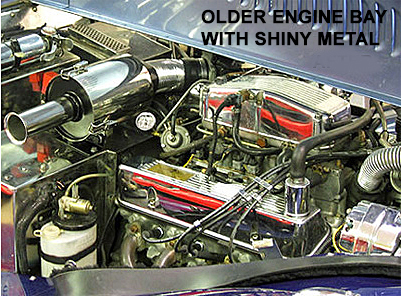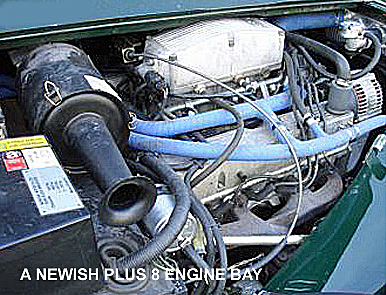EVERYTHING
YOU WANTED TO KNOW ABOUT CHROME!
Types
Hard Chrome
Show Chrome
Triple Chrome
Nickel Chrome
Black Chrome
Color chrome
Hexavalent Chromium
Tri Chrome
THE BOTTOM LINE:
I'll start with this part up front. I have a merited reputation of
loving shiny metal. Chroming offers the shiny metal connaisseurs :)like
myself the ultimate of this genre with a choice of undertones to
deligfht the senses. HOWEVER, I have found I must turn   away from it. Even many Concours competitors, who rarely, if ever, drive their collector cars began to agree many years ago. Chrome
is a lovely metal covering, like paint. It will crack under impact and
allow rust underneath. Road debris will make it pit. It is toxic and
has been restricted by government with many regulations making it
tedious and expensive to repair. away from it. Even many Concours competitors, who rarely, if ever, drive their collector cars began to agree many years ago. Chrome
is a lovely metal covering, like paint. It will crack under impact and
allow rust underneath. Road debris will make it pit. It is toxic and
has been restricted by government with many regulations making it
tedious and expensive to repair.
There are many shiny metal alternatives now of which the most popular
is high grade polished stainless (the Morgan factory often uses lower
grade unpolished stainless steel..which is why it stains so quickly. A great pity as higher grade polished stainless costs neglibly more. I favour polished stainless as a chrome substitute. I prefer the glorious undertones achievable with chrome. Polished stainless stell has a yellow undertone which is fine, but not as amazing, but only shiny metal enthusiasts care. Quality
polished stainless steel, is a forever product. When impacted, it dents
rather than cracks a chrome surface protection and allows corrosion
underneath running underneath the adjacent chrome surface. It never (if
it is of sufficent quality stainless steel grade) rusts. Happily, most
Morgan parts have been copied in polished stainless steel, making ss
replacements much easier than it once was. It requires little or no
maintenance. Chroming should be reserved to treating existing car parts that are not available in ss and for non-impact areas and usage.
There is nothing that shows a mechanic, professional or hobbyist,
that the owner of a collector car knows little about their car as much as
a dirty engine bay.
|
Chrome is slang for
Chromium, one of the 90-odd naturally occurring chemical elements. Chrome
is a metal, but it is not useful as a solid, pure substance. Things are never
made of solid chrome. Rather, when you hear that something is chrome, what
is really meant is that there is a thin layer of chrome, a plating of chrome,
on the object (the bulk of the object usually being steel, but occasionally
aluminum, brass, copper, plastic, or stainless steel).
A cause of occasional
confusion is the fact that people may tend to describe any shiny finish as
"chrome" even when it really has nothing to do with chromium. For example,
brightly polished aluminum motorcycle parts, electropolished stainless steel
boat rigging, vacuum metallized balloons and helmets, shiny painted wheels,
and nickel plated oven racks are sometimes called 'chrome' by the lay person.
Indeed it's not always easy to tell chrome plating from other finishes if
the parts are not side by side. When a decorative chrome electroplated finish
sits right next to another bright finish, however, the other finish usually
won't compare very favorably.
Chrome plating is
more reflective (brighter), bluer (less pale, grayish, or yellowish), and
more specular (the reflection is deeper, less distorted, more like a mirror)
than other finishes. Put one end of a yardstick against a bright finish,
and see how many inches of numbers you can clearly read in the reflection
-- you can clearly see the clouds in the sky reflected in chrome plating.
And there's a hard to define "glint" to top quality chrome plating that nothing
else has.
Chrome plating is
a kind of finishing treatment that utilizes the electrolytic deposition of
chromium. The thin, decorative bright chrome is the most common form of chrome
plating. Chrome plating imparts a mirror-like finish to items such as automotive
trim. Thicker deposits, called hard chrome, are used to reduce friction and
wear and to restore the dimensions of equipment that has experienced wear.
These two types of chromium plating are called Show Chrome and Hard Chrome
respectively.
The newest is called Vacuum Metallizing. During
the process, metals are vaporized within a vacuum chamber and then deposited
on to a surface. Once the vapor deposition process has completed, the substrate
emerges from the vacuum chamber with a mirror-like highly reflective finish.The
most common usage being with various grades of metal and plastics. Aluminum,
steel, polycarbonate, zinc die cast, ABS, acrylic, nylon and polyester are
examples of these.
Paints and Coatings
are commonly used in vacuum metallizing finishing for a number of reasons:
adhesion promotion, surface leveling and protection of the optical film after
deposition. These coatings are commonly referred to as vacuum metallizing
basecoats, topcoats and primers. It is very commonly used in the manufacture
of interior and exterior grade automotive, mirror fabrication and trim accessories.
Hard Chrome Plating
There are
two types of Industrial chromium plating solutions: hexavalent chromium
baths = main ingredient is chromic anhydride. And trivalent
chromium baths = main ingredient is chromium sulfate or chromium
chloride. Trivalent chromium baths are not yet common, due to
restrictions concerning color, brittleness, and plating
thickness. Hard chrome is plated to a thickness required to take
advantage of the extremely low chrome coefficient of friction, or for
wear build-up for functional purposes. Most people would not be
very familiar with hard chrome plating. Hard chrome plating or
Industrial Chrome is chrome plating that has been applied as a fairly
heavy coating (usually measured in thousandths of an inch) for wear
resistance, lubricity, oil retention, and other 'wear' purposes. Some
examples would be rollers, piston rings or motorcycle fork stanchions
etc. 'Hard chrome' is not really harder than other chrome plating, it
is called hard chromium because it is thick enough that a hardness
measurement can be performed on it, whereas decorative chrome plating
is only millionths of an inch thick and will break like an eggshell if
a hardness test is conducted, so its hardness can't really be measured
directly. Hard Chroming is not as reflective as 'decorative
chrome plating' and is not a finish you would want on say a bumper or a
wheel.
Chrome is a perfect
plating for longwearing working surfaces because it is much harder than case-hardened
steel. Micro-finished chrome will provide a coefficient of friction lower
than any other metal when used against steel, iron, brass, bronze, babbitt,
or aluminium alloys. It is used for bearing surfaces. We recommend hard chrome as the best
choice for Morgan kingpins. Click HERE. In industrial
chrome plating the process is electrolysis. In the process chromium metal
is deposited on metallic surfaces submerged in a chromic acid plating bath.
The part to be plated is made cathodic by connection to the negative terminal
of the rectifier.
| WATCHPOINT: It is not advisable
to us chrome on chrome. |
Show or
Decorative Chrome
Decorative chrome plating
is sometimes called nickel-chrome plating because it always involves electroplating
nickel onto the object before plating the chrome (it sometimes also involves
electroplating copper onto the object before the nickel, too). The nickel
plating provides the smoothness, much of the corrosion resistance, and most
of the reflectivity. The chrome plating is exceptionally thin, measured
in millionths of an inch rather than in thousandths.
When you look at a decorative chrome plated surface, such as a chrome plated
wheel or car bumper, most of what you are seeing is actually the effects
of the nickel plating. The chrome adds a bluish cast (compared to the somewhat
yellowish cast of nickel), protects the nickel against tarnish, minimizes
scratching, and symbiotically contributes to corrosion resistance. But the
point is, without the brilliant leveled nickel undercoating, you would not
have a reflective, decorative surface .For decorative purposes, the best combination
would be chrome and nickel which offers the most protection against corrosion.
It will have a mirror finish that will only be as good as the finish you
put on the surface before you put on the chrome.
Chrome plating should
be uniform in thickness on all surfaces. The plate should be smooth, homogeneous
and free from frosty areas, pin holes, pits, nodules, and other defects It
is not a difficult process provided that the part has been properly cleaned
and the following requirements met:
Triple
Chome Plating
Triple
chrome plating refers to decorative chrome. It implies three layers of
chrome but instead delineates the use of three different metal layers
as plating. Chrome is the final or top layer, and nickel is always the
second layer, providing most of the brilliance associated with
"chrome." The base or first layer fluctuates between steel, copper or
nickel or even aluminum.
Buzzwords: "Chrome Plating", "Double Nickel-Chrome", "Show Chrome", "Triple Chrome"
"Show chrome" probably means chrome that is good enough to be on a
winning entry in a car show. Chrome-lovers believe that the key to
"show chrome" is to copper plate the item first and then buff the
copper to a full lustre before starting the nickel plating.
Whether you start with bare steel or buffed copper, at least two layers
of plating follow -- a layer of nickel and a layer of chrome.
Salespeople are always looking for advantage, and they will use any
good-sounding terms they can get away with! There are no laws that
define what triple chrome plating actually means, so salespeople will
be prone to call their service "triple chrome plating" if there are a
total of 3 layers of any kind of plating, or "quadruple chrome plating"
if there are 4. So those terms mean little.
Chrome plating is hardly a matter of dipping an article into a tank, it
is a long involved process that often starts with tedious polishing and
buffing, then cleaning and acid dipping, zincating (if the part is
aluminum), and copper plating. For top reflectivity "Show Chrome", this
will be followed by buffing of the copper for perfect smoothness,
cleaning and acid dipping again, and plating more copper, then two or
three different types of nickel plating, all before the chrome plating
is done. Rinsing is required between every step.

 away from it. Even many Concours competitors, who rarely, if ever, drive their collector cars began to agree many years ago. Chrome
is a lovely metal covering, like paint. It will crack under impact and
allow rust underneath. Road debris will make it pit. It is toxic and
has been restricted by government with many regulations making it
tedious and expensive to repair.
away from it. Even many Concours competitors, who rarely, if ever, drive their collector cars began to agree many years ago. Chrome
is a lovely metal covering, like paint. It will crack under impact and
allow rust underneath. Road debris will make it pit. It is toxic and
has been restricted by government with many regulations making it
tedious and expensive to repair.